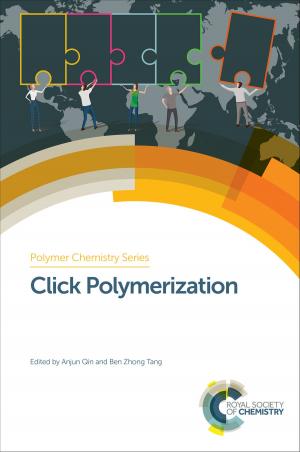PMR Spectroscopy: Solved Problems Volume : II
Nonfiction, Science & Nature, Science, Chemistry, Organic| Author: | Nitin D. Gaikwad | ISBN: | 9781370130795 |
| Publisher: | Nitin D. Gaikwad | Publication: | October 3, 2016 |
| Imprint: | Smashwords Edition | Language: | English |
| Author: | Nitin D. Gaikwad |
| ISBN: | 9781370130795 |
| Publisher: | Nitin D. Gaikwad |
| Publication: | October 3, 2016 |
| Imprint: | Smashwords Edition |
| Language: | English |
This book aims to teach students how to solve the Proton Magnetic Resonance (PMR) Spectroscopy problems when PMR data is given for the organic molecules themselves. Almost all available books, on spectroscopy describe Theory, Instrumentation and all the basic concept regarding spectroscopy. This book confronts the student with the PMR spectroscopy examples by showing how each proton due to its different chemical environment shows different chemical shift value, also how protons coupled with neighboring protons and how it shows the splitting pattern. The PMR spectroscopy problem solving approach is learnt by students from this book who then solved themselves all types of PMR problems in examination by practicing a series of problems in this book.
In this book Theoretical explanation is not given, it emphasizes the understanding of the technique actually used in solving the problems and the concept of identifying "structural fragments" and the logic needed to produce a structure out of the structural fragments. It is not a conventional text book with detailed text explanation. In short this book understands quickly and giving information about chemical shift value in particular functional groups, coupling constants in aliphatic, aromatic, saturated and unsaturated systems in organic molecules, splitting pattern with neighbouring proton/ protons. Also the book has planned the sequence of problems to demonstrate the use of new organic molecule and to test their understanding of PMR spectroscopy. Each problem is followed by sites of Unsaturation and then structure of the organic molecules with assigned chemical shift value for each proton, its coupling constants and splitting patterns, so that if the student fails to solve a problem then they will understand the problem better. The students have to continuously self-assess through the solving problems from this book themselves by using the PMR data.
The book aims to allow students to solve or read themselves PMR data or PMR spectrum but it shouldn’t mean any less work for them. Because students discover what they don’t know, they should have more sensible questions to ask when they were solving PMR problems. The book should do the ground work and you should be able to set suitable programme and discuss then profitably. The book itself has plenty of problems of this sort.
Though this book may introduce you PMR spectroscopy, its main aim is to suggest a PMR solving approach to the organic molecules. You therefore need to have a reasonable grounding in organic spectroscopy, so that you are familiar with most basic PMR spectroscopy. If you are under graduate student with no much experience of spectroscopy or limited knowledge of spectroscopy in practice you will probably be able to work straight through the book to learn the actual problem solving approach. The point of book learning is that you learn at your own pace and that you yourself check on your own progress. This book was produced principally to assemble a collection of problems that consider satisfactory for understanding the PMR problem solving approach.
This book aims to teach students how to solve the Proton Magnetic Resonance (PMR) Spectroscopy problems when PMR data is given for the organic molecules themselves. Almost all available books, on spectroscopy describe Theory, Instrumentation and all the basic concept regarding spectroscopy. This book confronts the student with the PMR spectroscopy examples by showing how each proton due to its different chemical environment shows different chemical shift value, also how protons coupled with neighboring protons and how it shows the splitting pattern. The PMR spectroscopy problem solving approach is learnt by students from this book who then solved themselves all types of PMR problems in examination by practicing a series of problems in this book.
In this book Theoretical explanation is not given, it emphasizes the understanding of the technique actually used in solving the problems and the concept of identifying "structural fragments" and the logic needed to produce a structure out of the structural fragments. It is not a conventional text book with detailed text explanation. In short this book understands quickly and giving information about chemical shift value in particular functional groups, coupling constants in aliphatic, aromatic, saturated and unsaturated systems in organic molecules, splitting pattern with neighbouring proton/ protons. Also the book has planned the sequence of problems to demonstrate the use of new organic molecule and to test their understanding of PMR spectroscopy. Each problem is followed by sites of Unsaturation and then structure of the organic molecules with assigned chemical shift value for each proton, its coupling constants and splitting patterns, so that if the student fails to solve a problem then they will understand the problem better. The students have to continuously self-assess through the solving problems from this book themselves by using the PMR data.
The book aims to allow students to solve or read themselves PMR data or PMR spectrum but it shouldn’t mean any less work for them. Because students discover what they don’t know, they should have more sensible questions to ask when they were solving PMR problems. The book should do the ground work and you should be able to set suitable programme and discuss then profitably. The book itself has plenty of problems of this sort.
Though this book may introduce you PMR spectroscopy, its main aim is to suggest a PMR solving approach to the organic molecules. You therefore need to have a reasonable grounding in organic spectroscopy, so that you are familiar with most basic PMR spectroscopy. If you are under graduate student with no much experience of spectroscopy or limited knowledge of spectroscopy in practice you will probably be able to work straight through the book to learn the actual problem solving approach. The point of book learning is that you learn at your own pace and that you yourself check on your own progress. This book was produced principally to assemble a collection of problems that consider satisfactory for understanding the PMR problem solving approach.















